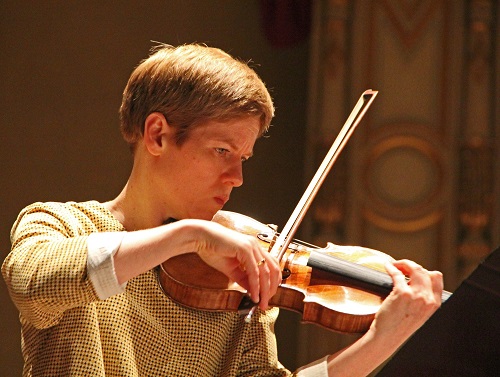 Canada Mozart, Bartók, Dvořák: Isabelle Faust (violin), Vancouver Symphony Orchestra, Kazuyoshi Akiyama (conductor), Orpheum Theatre, Vancouver, 30.4.2016. (GN)
Canada Mozart, Bartók, Dvořák: Isabelle Faust (violin), Vancouver Symphony Orchestra, Kazuyoshi Akiyama (conductor), Orpheum Theatre, Vancouver, 30.4.2016. (GN)

Mozart: Overture to Don Giovanni, K. 527
Bartók: Violin Concerto No. 2, BB117
Dvořák: Symphony No. 7 in D minor, Op. 70
One would expect Isabelle Faust’s interpretation of Bartók’s Second Violin Concerto to have a certain authenticity, as she initially studied the composer with Hungarian violinist Dénes Zsigmondy, who knew Bartók personally. In fact, it has much more than that: it is quite spectacular in its range, clarity and detailing, capturing both the work’s jagged edges and full lyrical expansiveness. And it is very Hungarian in feeling, often finding both the wiry fiber and elusive inward half-lights of the composer’s world that many smoother, more romantic interpretations do not. Faust started recording Bartók early in her career: her disc of the Bartók Violin Sonatas for Harmonia Mundi won the Gramophone Young Artists Award 15 years ago. More recently, in 2013, she recorded both of the composer’s Violin Concertos with conductor Daniel Harding, correcting parts of these scores through historical documents from the Bartók Archive in Budapest. Kazuyoshi Akiyama, the VSO’s Conductor Laureate, accompanied the violinist on this voyage and added his own fire in the Mozart and Dvořák.
One could hardly help but be swept away by the violinist’s opening entry in the Allegro: so pure, so full of radiant, lyrical expanse, blossoming forth with both joy and bittersweet yearning. The length of her line was disarming: I have likely never seen any violinist extend the opening paragraph so far and with so much cohesion. As we moved to the grittier, more biting material, her precision and dynamic gradations in the rapid fire, double-stopping sequences were stunning. Half-lights frequently came into play, where a sudden meditative musing takes over the music, only to be broken quickly by sharper postures. In Faust’s hands, calm always played off against driving motion, and the jagged always played off against the lyrical, while her tone could move very quickly from a thin whisper to a full sensual lusciousness. All of this was so intelligently balanced that I just about forgot that she was playing her ‘Sleeping Beauty’ Stradivarius (1704), and that she played with the score in front of her (though, interestingly, I only saw her turn pages once or twice in the whole work),
There has been a tendency to treat the Andante as a true ‘slow movement’, and many classic interpreters (Menuhin, for one) have generated a lovely withdrawn tenderness and suspension over its length. This interpretation treated it more like what it actually is: a ‘theme and variations’. The opening was plainer and less meditative, though still touching. Part of this character was doubtlessly due to the violinist’s recent discovery of Bartók‘s handwritten ‘without vibrato’ for the opening notes. Even if I missed some of the movement’s mystical unity, its variety was revealed in such an interesting way, the violinist offering a full continuum of emotional shadings and tone colours en route. It was only in the big orchestral outburst close to the end that I perhaps felt some fragmentation, but that may be simply my own failing. The finale was splendid in the way it recalled all the same varied tensions of the opening movement – as indeed it should, since their thematic material is strongly linked. When the lyrical opening theme of the first movement is recalled, the violinist brought the work home with exactly the type of organic unity it should have.
This was a wonderfully accomplished reading from Isabelle Faust but, unfortunately, a ‘great’ performance requires the cooperation of the orchestra too. Maestro Akiyama certainly gave a solid and conscientious reading of the orchestral part, but it was still a little too plain and generalized, with less than full attention to dynamic levels and internal balance. The climaxes tended to be somewhat lumpy, rather than full and brazen. I also noticed a lack of sharpness: the winds did not have enough Hungarian piquancy and rhythmic point, and the sheer novelty of some of the instrumentation did not surface. Whereas the soloist had remarkably long vision, my impression was that the orchestra did not match her.
Maestro Akiyama nonetheless brought out real strength and fire elsewhere: the opening Don Giovanni overture had electricity and frisson at its close, and much the same could be said for Dvořák’s 7th Symphony. Tempos for the symphony were particularly well chosen, and it had good natural line and flow. While some of the wind and horn passages may have lacked rustic character, and the Scherzo was rhythmically a little square, the important unifying ingredients were that the climaxes in both the opening and closing movements were strong and perfectly judged, and there was considerable natural warmth in the slow movement. The finale had a fine sense of inevitability and built to its end with full power and majesty. I assure you, everyone went home happy after this one.
Geoffrey Newman
Previously published in a slightly different form on http://www.vanclassicalmusic.com
